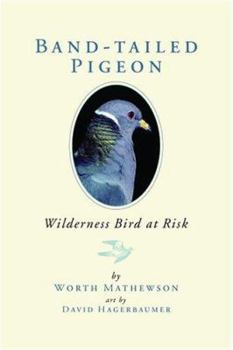Band-Tailed Pigeon: Wilderness Bird at Risk
"A longtime hunter in the coastal range of Oregon takes stock of his favorite prey, the band-tailed pigeon," reported The New York Times in the summer of 2003. What made Worth Mathewson's writing about the western wilderness pigeon newsworthy is not his elegant evocation of the damp, spicy scent of a Pacific Northwest river valley or his keen observations of bandtails flying high and fast over a canyon. Rather the press took note of an avid hunter blaming overhunting and bad management for the devastation of a species. Wary by nature yet brave under fire, the magnificent bandtail has long thrilled the sportsman. Some attribute the bird's decline to habitat loss, but Mathewson, in this complete natural history, carefully builds his case to the contrary. While trichomoniasis and spraying of broadleaf trees may contribute, the human factor is paramount: a persistently callous attitude toward Patagioenas fasciata may keep it in a downward spiral. If modest protections are lifted at the first signs of recovery, its fate may be sealed. With drawings by noted wildlife artist David Hagerbaumer, color photographs by the author and Margaret Thompson Mathewson, and an extensive bibliography, this finely rendered, affecting portrait of a wild bird with a troubled past is nothing short of a call to action.
Format:Hardcover
Language:English
ISBN:0881927120
ISBN13:9780881927122
Release Date:January 2005
Publisher:Timber Press (OR)
Length:183 Pages
Weight:0.90 lbs.
Dimensions:0.8" x 5.6" x 8.2"
Customer Reviews
1 rating
My Bird Book
Published by Thriftbooks.com User , 18 years ago
I love the way the band tailed pigeon spreads its wings, upside down, and clings form the branches of trees if it thinks that's the best way to catch a recalcitrant berry or acorn. The author, who took almost thirty years to write this book, knows his stuff, and he interviews old folks, some born as far back as the 1800's, to gather their memories of a long-forgotten day when the "blue rock" pigeon was as common as an ordinary housefly. One dignified elderly lady remembers trying to avoid flocks of bandtails because her horse would get a-skeered of their sudden movements in the cane. Matthewson is not only a hunter, but he knows the other side of the story too. As Shakespeare says, the Canadian woods are becoming "bare ruined choirs where late the sweet birds sang." Not that the blue rock was ever famous for its singing voice! But those who have heard the rustle of its wings would not exchange that experience for a whole host of Renata Tebaldis. The pigeons in question are sometimes mistaken for parrots or parakeets, based on their strange manipulative powers. They can grab just about anything and wrest it away, like taking candy from a baby. If they have been able to survive, even when a whole nation of hunters were given carte blanche to decimate them. Now, with overhunting, only a few remain, and every time you see them in action it's a red letter day. Mathewson proffers his opinion, delivered in his casually understated way, that "Overall, in my opinion, an adult male bandtail on an emerald green Douglas fir bough is about as beautiful a bird as the Northwest has to offer." May I say that out of all the angler naturalists who are still writing handbooks, that a good passage by Worth Mathewson is about as inspiring a paragraph as the Public Library has to offer you. The bandtail, however, isn't even his favorite looking pigeon (that honor goes to the white crown pigeon, the placid bird my grandfather used to refer to as the "chef with the white hat"). Buy this one together with his famous biography of the rogue wildlife photographer, William Finley.





